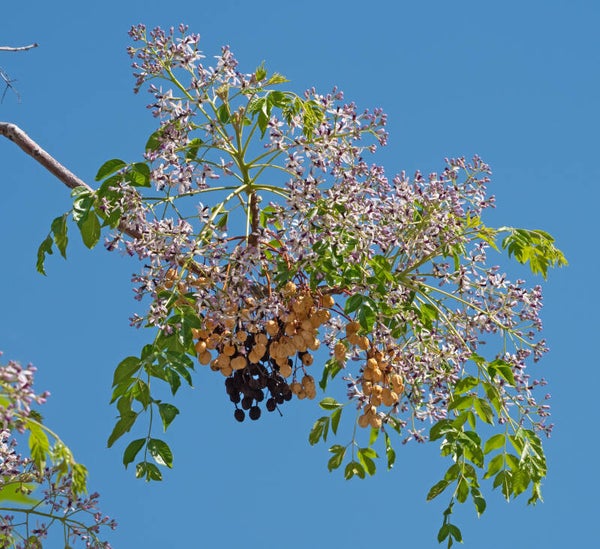Melia azedarach, chinaberry tree, pride of India, Persian lilac, 20-100 seeds
Melia azedarach, commonly known as the chinaberry tree, pride of India, bead-tree, Cape lilac, syringa berry tree, Persian lilac, Indian lilac, or white cedar, is a species of deciduous tree in the mahogany family, Meliaceae, that is native to Indomalaya and Australasia.
The fully grown tree has a rounded crown, and commonly measures 7–12 metres (20–40 ft) tall, however in exceptional circumstances M. azedarach can attain a height of 45 metres (150 ft).
The flowers are small and fragrant, with five pale purple or lilac petals, growing in clusters.
The fruit is a drupe, marble-sized, light yellow at maturity, hanging on the tree all winter, and gradually becoming wrinkled and almost white.
The main utility of chinaberry is its timber.
The tough five-grooved seeds were widely used for making rosaries and other products requiring beads.
In Kenya the trees have been grown by farmers and used as fodder trees. The leaves can be fed to cattle to improve milk yields and improve farm incomes.
Fruits are poisonous or narcotic to humans if eaten in quantity.
The plant was introduced around 1830 as an ornamental in the United States (South Carolina and Georgia) and widely planted in southern states. Today it is considered an invasive species by some groups as far north as Virginia and Oklahoma. But nurseries continue to sell the trees, and seeds are also widely available. It has become naturalized to tropical and warm temperate regions of the Americas and is planted in similar climates around the world.
Sowing time: summer, all year round (subject to temperature conditions)
Germination temperature: 25-35°C
Pre-Treatment: scarification, Gibberellic acid GA3 100 ppm, Potassium nitrate KNO3 1%
Sowing mix: compost for seeds and cuttings
Water: keep moist
Germination time: 17-36 days
Germination Method: rub the seeds between 2 pieces of sandpaper and soak in warm water for 24 hours. For better germination rate it is recommended to soak the seeds in GA3 or KNO3. With the recommended pre-treatment the germination percentage will increase to 75% comparing to 25% in not treated seeds.
The best germination results will be reached in alternating temperatures +20°C at night and +30°C during the day or +25°C/+35°C (at constant temtepature +35°C germination percentage will be around 30% comparing to about 80% at alternating temperatures).
If you germinate seeds in sealed container or zip lock bag plant them in the individual pots 1 cm deep, put them in the place where the temperature will remain close to germination temperature.
Once the young seedlings got the first true leaves you can start fertilizing them with organic fertilizer or all-purpose commercial fertilizer half of the recommended concentration.
Melia azedarach grows at an extremely fast rate (1.5-3.0m or 5-10 feet each year for the first 2 years!) It can reach 6-8 meters in height within four or five years, maximum height 12-16m. The plant reaches maturity in 6–10 years and can develop viable seeds. The seeds of the plant can remain viable for number of years.
M. azedarach is highly tolerant of heat, drought, and poor soil conditions, and can quickly provide dense shade.
The plant is capable of producing large number of bird-dispersed seeds, thus enabling it to colonise an area if left unchecked.

















